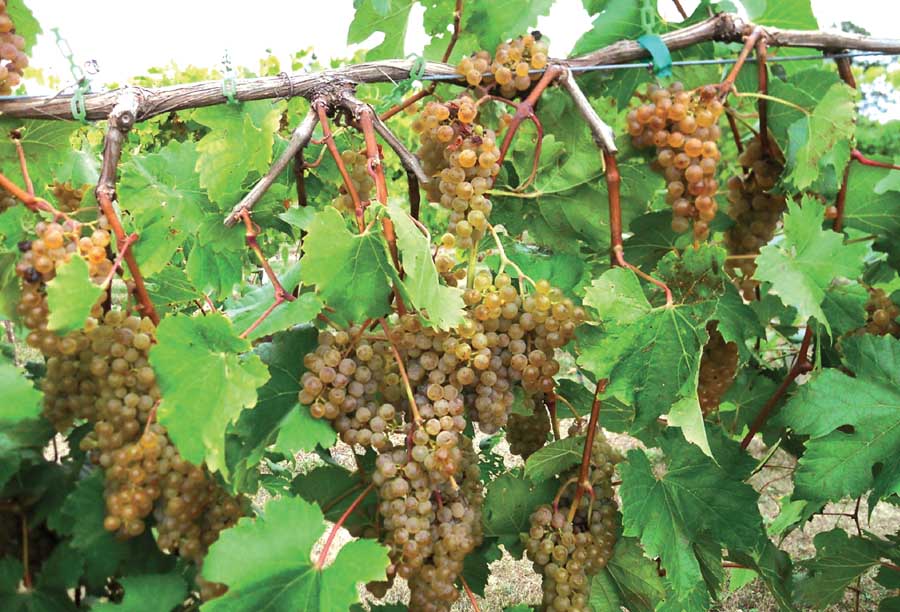
Itasca grape clusters weigh from 95 to 145 grams, can be winged or shouldered and show a golden hue at harvest. (Courtesy John Thull)
The University of Minnesota has announced its newest cold-hardy wine grape variety, and it’s one for which north country grape growers have been waiting.
Called the Itasca for the lake in northern Minnesota identified as the source of the Mississippi River, the white grape has a lower acidity than other cold-hardy varieties and high sugar, potentially making it an ideal candidate for a dry white wine.
The variety also shows resistance to downy and powdery mildew, as well as phylloxera, and it is hardy to USDA’s Plant Hardiness Zone 4.
Provenance
The Itasca has been in development since 2002. Originally tagged as MN 1285, it was created from a cross pollination of Frontenac Gris and MN 1234, a Seyval Blanc offspring known for its resistance to powdery mildew.
Two of its ancestors are accessions of Vitis riparia, from which it acquired its high sugar — and its cold-hardiness.
In 2014, the winter of the Polar Vortex, Frontenac Gris had a 25 percent bud survival rate, while Itasca endured the same weather and emerged with 65 percent primary bud survival, said Matt Clark, a University of Minnesota assistant professor and grape breeder.
Though not certified yet, the variety has been submitted to the Clean Plant Center Northwest in Prosser, Washington.
To date, they’ve done a few performance evaluations with some growers but no large-scale vineyard or winery trials.
The university has licensed three nurseries to sell its new variety for the 2017 season: Winterhaven Vineyard and Nursery in Janesville, Minnesota; Double A Vineyards in Fredonia, New York; and Northeastern Vine Supply in West Pawlet, Vermont. Knight Hollow Nursery of Middleton, Wisconsin, uses a tissue culture for micropropagation.
Grower friendly
Vines can be vigorous, depending on the soil. The breeders have found vine spacing should be 6 feet apart when organic matter is 2.5 percent or less and 8 feet apart for 3 percent or more. “Irrigation is important for establishment,” Clark said.
Its growth habit is open and manageable. Shoots can either grow upright or procumbent. “Fruit exposure is good with minor adjustments,” he said.
The university vines hang on high-wire, double cordon systems. Clark said he thinks they can be trained to vertical shoot positioning, though it’s not been tested yet. Kicker shoots on the trunk can reduce vine growth, and should be pruned off or back to short spurs, he said.
Clark said they don’t have very good data on when bud break occurs. “It didn’t seem to be as early as Marquette, but may be in the same time frame as Frontenac,” he said. The fruit ripens earlier than Frontenac, by mid- to late September. Cluster structure is moderately compact, weighing in at 95 to 145 grams, is cylindrical and can be shouldered or winged.
Berries take on a golden hue when ripe, with some clusters showing one or two pronounced rosy berries. The fruit has flavors of pear, gooseberries, honeydew melon and star fruit.
The juice
So far, the university has only produced about eight gallons of wine this year, fermented in glass or plastic. Grape berries were harvested, destemmed and pressed in one day and inoculated with yeast on the second day to dry, Clark said.
With a pH of 3.05 to 3.35, Itasca has 30 percent less acid than Minnesota’s other cold-hardy varieties, a gift from its European parents. “It has lots of French in its background,” Clark said. He said they try to pick the grapes at 26 Brix, but depending on where they are planted, the variety can deliver up to 28 Brix.
The titratable acidity (TA) of Itasca’s juice is much lower than the other Minnesota cold-hardy varieties, such as Frontenac, which sports 15 to 16 grams per liter.
“It has titratible acidity in the 9 to 10 grams per liter range, putting it more in line with other vinifera varietal dry table wines like Sauvignon Blanc or even Riesling,” said Bryan Forbes, the University of Minnesota’s cold-hardy wine grape breeding program interim winemaker.
Itasca can make a crisp, white wine but it is also very versatile, Forbes said. Using malolactic fermentation, for example, a winemaker could make a wine similar to that of a typical Chardonnay, with a richer, potentially buttery character.
It is not hyper-aromatic like a Muscat nor is it bracing on the tongue. “It’s pretty zippy but it is not an assault,” he said.
Clark deferred to Forbes for a more expert opinion, but allowed the wine would do best on its own. “It would also be nice to blend with high-acid wines to improve mouth feel and flavor,” he said. •
– by Dave Weinstock






Leave A Comment